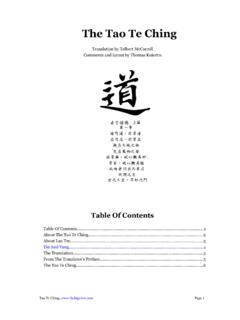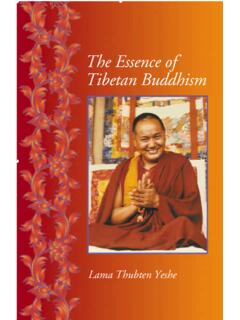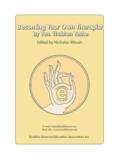Transcription of Four Noble Truths - Tripod.com
1 four Noble Truths By His Holiness the Dalai Lama at Dharamsala, India 1981 (Last Updated Apr 12, 2010) His Holiness the Dalai Lama gave this teaching in Dharamsala, 7 October 1981. It was translated byAlexander Berzin, clarified by Lama Zopa Rinpoche, edited by nicholas ribush and first published in thesouvenir booklet for Tushita Mahayana Meditation Centre's Second Dharma Celebration, November 5-81982, New Delhi, India. Published in 2005 in the LYWA publication Teachings From Tibet. When the great universal teacher Shakyamuni Buddha first spoke about the Dharma in the Noble land ofIndia, he taught the four Noble Truths : the Truths of suffering, the cause of suffering, the cessation of sufferingand the path to the cessation of suffering. Since many books contain discussions of the four Noble Truths inEnglish, they (as well as the eightfold path) are very well These four are all-encompassing, includingmany things within them.
2 Considering the four Noble Truths in general and the fact that none of us wants suffering and we all desirehappiness, we can speak of an effect and a cause on both the disturbing side and the liberating side. Truesufferings and true causes are the effect and cause on the side of things that we do not want; true cessationand true paths are the effect and cause on the side of things that we desire. The truth of suffering We experience many different types of suffering. All are included in three categories: the suffering ofsuffering, the suffering of change and all-pervasive suffering. Suffering of suffering refers to things such as headaches and so forth. Even animals recognize this kind ofsuffering and, like us, want to be free from it. Because beings have fear of and experience discomfort fromthese kinds of suffering, they engage in various activities to eliminate them.
3 Suffering of change refers to situations where, for example, we are sitting very comfortably relaxed and atfirst, everything seems all right, but after a while we lose that feeling and get restless and uncomfortable. In certain countries we see a great deal of poverty and disease: these are sufferings of the first realizes that these are suffering conditions to be eliminated and improved upon. In many Westerncountries, poverty may not be that much of a problem, but where there is a high degree of materialdevelopment there are different kinds of problems. At first we may be happy having overcome the problemsthat our predecessors faced, but as soon as we have solved certain problems, new ones arise. We haveplenty of money, plenty of food and nice housing, but by exaggerating the value of these things we renderthem ultimately worthless. This sort of experience is the suffering of very poor, underprivileged person might think that it would be wonderful to have a car or a television setand, should he acquire them, would at first feel very happy and satisfied.
4 Now, if such happiness werepermanent, as long as he had the car and the TV set he would remain happy. But he does not; his happinessgoes away. After a few months he wants another kind of car; if he has the money, he will buy a bettertelevision set. The old things, the same objects that once gave him much satisfaction, now causedissatisfaction. That is the nature of change; that is the problem of the suffering of change. All-pervasive suffering is the third type of suffering. It is called all-pervasive [Tib: kyab-pa du-che kyi dug-ng l1/5 literally, the suffering of pervasive compounding] because it acts as the basis of the first two. There may be those who, even in developed countries, want to be liberated from the second suffering, thesuffering of change. Bored with the defiled feelings of happiness, they seek the feeling of equanimity, whichcan lead to rebirth in the formlessness realm that has only that feeling.
5 Now, desiring liberation from the first two categories of suffering is not the principal motivation for seekingliberation [from cyclic existence]; the Buddha taught that the root of the three sufferings is the third:all-pervasive suffering. Some people commit suicide; they seem to think that there is suffering simplybecause there is human life and that by ending their life there will be nothing. This third, all-pervasive,suffering is under the control of karma and the disturbing mind. We can see, without having to think verydeeply, that this is under the control of the karma and disturbing mind of previous lives: anger and attachmentarise simply because we have these present The aggregate of compounding phenomena is likean enabler for us to generate karma and these disturbing minds; this is called n -ng n len [literally, taking abad place]. Because that which forms is related to taking the bad place of disturbing minds and is under theircontrol, it supports our generating disturbing minds and keeps us from virtue.
6 All our suffering can be tracedback to these aggregates of attachment and clinging. Perhaps, when you realize that your aggregates are the cause of all your suffering, you might think thatsuicide is the way out. Well, if there were no continuity of mind, no future life, all right if you had the courageyou could finish yourself off. But, according to the Buddhist viewpoint, that s not the case; your consciousnesswill continue. Even if you take your own life, this life, you will have to take another body that will again be thebasis of suffering. If you really want to get rid of all your suffering, all the difficulties you experience in yourlife, you have to get rid of the fundamental cause that gives rise to the aggregates that are the basis of allsuffering. Killing yourself isn t going to solve your this is the case, we must now investigate the cause of suffering: is there a cause or not?
7 If there is,what kind of cause is it: a natural cause, which cannot be eliminated, or a cause that depends on its owncause and therefore can be? If it is a cause that can be overcome, is it possible for us to overcome it? Thuswe come to the second Noble truth , the truth of the cause of suffering. The truth of the cause of sufferingBuddhists maintain that there is no external creator and that even though a buddha is the highest being, evena buddha does not have the power to create new life. So now, what is the cause of suffering?Generally, the ultimate cause is the mind; the mind that is influenced by negative thoughts such as anger,attachment, jealousy and so forth is the main cause of birth and all such other problems. However, there is nopossibility of ending the mind, of interrupting the stream of consciousness itself. Furthermore, there is nothingintrinsically wrong with the deepest level of mind; it is simply influenced by the negative thoughts.
8 Thus, thequestion is whether or not we can fight and control anger, attachment and the other disturbing negativeminds. If we can eradicate these, we shall be left with a pure mind that is free from the causes of suffering. This brings us to the disturbing negative minds, the delusions, which are mental factors. There are manydifferent ways of presenting the discussion of the mind, but, in general, the mind itself is something that ismere clarity and awareness. When we speak of disturbing attitudes such as anger and attachment, we haveto see how they are able to affect and pollute the mind; what, in fact, is their nature? This, then, is thediscussion of the cause of suffering. If we ask how attachment and anger arise,3 the answer is that they are undoubtedly assisted by our graspingat things to be true and inherently real. When, for instance, we are angry with something, we feel that theobject is out there, solid, true and unimputed, and that we ourselves are likewise something solid andfindable.
9 Before we get angry, the object appears ordinary, but when our mind is influenced by anger, the2/5object looks ugly, completely repulsive, nauseating; something we want to get rid of immediately it appearsreally to exist in that way: solid, independent and very unattractive. This appearance of truly ugly fuels ouranger. Yet when we see the same object the next day, when our anger has subsided, it seems more beautifulthan it did the day before; it s the same object but it doesn t seem as bad. This shows how anger andattachment are influenced by our grasping at things as being true and unimputed. Thus, the texts on Middle Way [Madhyamaka] philosophy state that the root of all the disturbing negativeminds is grasping at true existence; that this assists them and brings them about; that the closed-mindedignorance that grasps at things as being inherently, truly real is the basic source of all our suffering.
10 Based onthis grasping at true existence we develop all kinds of disturbing negative minds and create a great deal ofnegative karma. In his Entering the Middle Way [Madhyamakavatara], the great Indian pandit Chandrakirti says that firstthere s attachment to the self, which is then followed by grasping at things and becoming attached to them as mine. 4 At first there is a very solid, independent I that is very big bigger than anything else; this is thebasis. From this gradually comes this is mine; this is mine; this is mine. Then we, we, we. Then, becauseof our taking this side, come others, our enemies. Towards I and mine, attachment arises. Towards him, herand them, we feel distance and anger; then jealousy and all such competitive feelings arise. Thus ultimately,the problem is this feeling of I not the mere I but the I with which we become obsessed.










